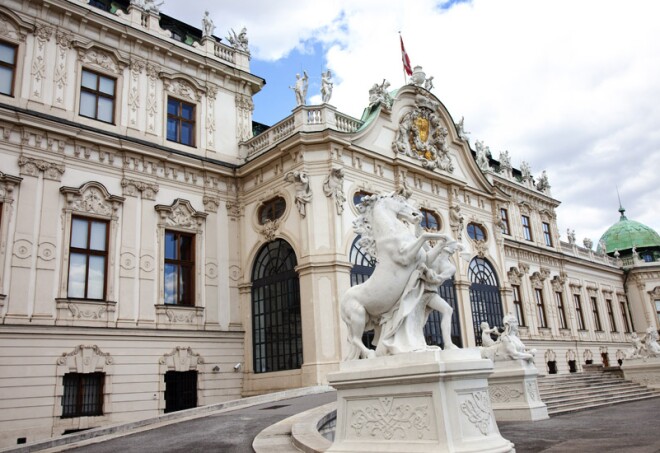If You Only Have Three Days in Vienna
If you only have 3 days in Vienna, you have to make it worthwhile. Few cities offer such a lively mix of history and culture. Vienna has become synonymous with music thanks to composers like Mozart, Strauß, and Haydn, and the influence of the House of Hapsburg can be seen in the Vienna’s incredible palaces, the Vienna State Opera, Spanish Riding School and plethora of Baroque architecture. Of course, Vienna’s famous coffeehouses & pastries make it worth a 3 day visit, at the very least!
Highlights
Heldenplatz 21/4, 1010 Wien, Austria
Rounding out your visit to Hofburg Palace is the last of the great expansions to the palace by the Habsurgs. The building was done in true neoclassical style, obviously to make the royal family appear as mighty as Greek gods. A statue of Archduke Charles II stands outside.
Friedrich-Schmidt-Platz 1, 1010 Wien, Austria
One of Vienna’s most notable structures is its stunning Rathaus, or City Hall. Designed by Friedrich von Schmidt between 1872 and 1883, the imposing Gothic structure is the seat of both the mayor and city council, and is also the backdrop for one of the most popular Christmas markets in the city.
Arsenal 1, 1030 Wien, Austria
History buffs definitely won’t want to miss out on the Museum of Military History, or Heeresgeschichtliches Museum. Focusing on Austria‘s military history from the 16th century up to 1945, exhibition halls are broken down into the Thirty Years’ War and the Ottoman Turks, the Napoleonic Wars, World War I, and World War II. Perhaps most notable is the display covering the Assassination of Archduke Franz Ferdinand in Sarajevo, which includes his uniform, the car in which he and his wife were riding, and the pistol used by Serbian Gavrilo Princip.
Opernring 2, 1010 Wien, Austria
Arguably one of Vienna’s most beautiful landmarks, the Opera is a cultural treasure. Not only has it hosted many outstanding works since its origin as the Wiener Hofoper in 1863, it’s associated with one of the world’s greatest philharmonics. The detailed interior, including marble staircase, serves as an elegant reminder of Vienna’s imperial history. Cheap (usually a few Euro), standing-room-only tickets are sold before each performance, which often brings out some of the most vocal audience members, for better or worse, depending on the performance.
Prinz Eugen-Straße 27, 1030 Wien, Austria
While “Belvedere” might provoke an image of just a single palace, it’s actually a large complex with two Baroque palaces (Upper and Lower), Orangery, Stables and beautiful park space in the 3rd District. It was built as a summer residence for Prince Eugene of Savoy. While the gardens and architecture alone make it worth a visit, its grandiose interiors and art collections are not to be missed. The galleries of the Upper Belvedere highlight Austrian art from the Middle Ages to the present, providing insight into the country’s culture and history. This includes works by Gustav Klimt and Egon Schiele, as well as impressive sections on Biedermeier, Expressionism and Baroque art.
Michaelerkuppel, 1010 Wien, Austria
Up until the end of World War I in 1918, the Hofburg was the center of the Habsburg dynasty and the Austro-Hungarian Empire. The massive complex includes the Österreichische Nationalbibliothek (National Library), Schatzkammer (Imperial Treasury), and, the most recent addition, the Neue Burg, completed in 1913. A visit should include the Imperial Apartments, each lavishly decorated in Baroque and Rococo styles, and the Sisi Museum, covering the life of Austria’s beloved (and actually Bavarian) Empress. It is also the official seat of the president of Austria.
1060 Vienna, Austria
Street-food markets are all the rage the world over, and in Vienna you have the chance to visit one that’s been around for many centuries. Built literally over the channeled Vienna River, just beyond the Ringstrasse, the Naschmarkt is devoted to what its name happens to sound like in English: noshing. Whether you order a spicy wurst, browse the fish and cheese stalls, or purchase local products like pumpkin-seed oil and apple vinegar, the Naschmarkt is one of the city’s most enjoyable simple pleasures. In recent years, some gastronomic and ethnic food stalls have expanded into full restaurants. For decades, 400 dealers have set up their Saturday flea market next door, where shoppers hunt for bargains among books, record albums and CDs, and antiques.
Maria-Theresien-Platz, 1010 Wien, Austria
The Habsburgs were, generally speaking, lovers of art and many of the works of the Kunsthistorisches Museum come from their collections. While the grandiose interior alone may be reason enough to visit, the collections here are outstanding. The Egyptian and Near Eastern Collection, Collection of Greek and Roman Antiquities and Coin Library are just a few of the collections to get lost inside. The Picture Gallery includes works by Albrecht Dürer, Jan van Eyck, Pieter Brueghel the Elder and Peter Paul Rubens.

















